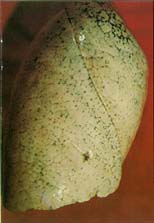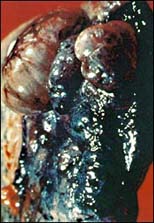 
|
TYPE OF CANCER| PREMATURE DEATH | |
| Bladder | |
| Cheek | |
| Esophagus | |
| Intestines | |
| Jaw | |
| Leg | |
| Lip | |
| Lung | |
| Miscellaneous | |
| Neck | |
| Pancreas | |
| Prostate | |
| Rectum | |
| Stomach | |
| Throat | |
| Tongue |
| acetaldehyde (1.4+ mg) | arsenic (500+ ng) | benzo(a)pyrene (.1+ ng) |
| cadmium (1,300+ ng) | crotonaldehyde (.2+ µg) | chromium (1,000+ ng) |
| ethylcarbamate 310+ ng) | formaldehyde (1.6+ µg) | hydrazine (14+ ng) |
| lead (8+ µg) | nickel (2,000+ ng) | radioactive polonium (.2+ Pci) |
Re the issue of coumarin as a "lung-specific carcinogen," there is now revealed a formerly secret document, "Project Coumarin - Top Secret." It reveals Philip Morris' concern that public health officials might learn of coumarin as an additive in cigarettes. It advised how to obstruct public health investigations. A copy is at the Philip Morris Document Site, reference "Bates Number" 2501046314/6317, URL, http://www.pmdocs.com/getallimg.asp?DOCID=2501046314/6317.
Actually, judicial notice of cigarettes' TTS deleteriousness was taken as long ago as pursuant to an an 1897 Iowa law. An 1897 Tennessee law did likewise, see the case of Austin v State, 101 Tenn 563; 566-7; 48 SW 305, 306; 70 Am St Rep 703 (1898) affirmed 179 US 343 (1900). Michigan soon thereafter (1909) passed a law banning unsafe cigarettes, law number MCL § 750.27, MSA § 28.216.
Due to cigarettes' deleterious nature and ingredients, they, when lit, emit deleterious emissions constituting "Toxic tobacco smoke" (TTS). The pertinent legal adjective is "ultrahazardous."
| acetaldehyde | 3,200 ppm | |
| acrolein | 150 ppm | |
| ammonia | 300 ppm | |
| carbon monoxide | 42,000 ppm | |
| formaldehyde | 30 ppm | |
| hydrogen cyanide | 1,600 ppm | |
| hydrogen sulfide | 40 ppm | |
| methyl chloride | 1,200 ppm | |
| nitrogen dioxide | 250 ppm |
In view of the above data, we now know that an underlying factor in the massive adverse effects cigarettes cause, is that their vast quantities of toxic chemicals impair the immune system. The underlying fact about TTS is that its massive quantities of toxic chemicals cause
"mutations of cellular genetic structures, deviation of cellular characteristics from their optimal normal state [leading to] a body-wide spectrum of disease."—R. T. Ravenholt, M.D., M.P.H., writing in 307 N Engl J Med (#5) 312 (29 July 1982)."Loss of activation of [normality] leads to a variety of immunologic disorders characterized by autoimmunity or immunodeficiency . . . Major immunologic abnormalities result from alterations in the mature T-cell subsets."—Ellis L. Reinherz, M.D. and Stuart F. Schlossman, M.D., "Regulation of the Immune Response—Inducer and Suppressor T-Lymphocyte Subsets in Human Beings," 303 N Engl J Med 370-373 (14 Aug 1980).
| "In 1963, Dr. [Oscar] Auerbach and his associates reported the results of an investigation that should settle the controversy of smoking and cancer once and for all.
"[They] collected 100,000 slides of cells from the bronchial tubes of . . . men and women who had died . . . from various causes . . . it was specifically established that the greatest cell damage occurred in the people who had been the heaviest smokers for the longest periods. "Not only were precancer cells identified on the slides of heavy smokers, but actually cancer cells were found on slides of people who had died from something else. Had they lived, they would have developed lung cancer in addition to their other ailments."—Alton Ochsner, M.D., Smoking and Your Life (New York: Julian Messner Pub, 1954 rev 1964), p 23. |
The bottom line is this: "There is no such thing as spontaneous generation. Nothing comes from nothing. Something causes cancer to appear," Ochsner, supra, p 20. We know what that "something" is. See also the article, "Smoking turns on genes -- permanently" (29 August 2007): "'Those genes and functions which do not revert to normal levels upon smoking cessation may provide insight into why former smokers still maintain a risk of developing lung cancer,' according to Raj Chari, first author of the study." (See also tobacco and birth defects data).
There is a marked contrast between smokers and nonsmokers. Smokers ALWAYS get lung cancer as above stated. As shown next, nonsmokers NEVER do.
Due to the prevalence of others' TTS, so-called nonsmokers are in fact regularly poisoned with cigarettes’ illegal massive, "ultrahazardous," toxic chemicals.
To find “the purest nonsmoking population that can be obtained in the USA,” one researcher analyzed lung cancer data on “the Amish population . . . in Lancaster County [Pennsylvania].” “The study was initiated to [ascertain] the incidence of lung cancer among a pure nonsmoking population . . . .” The result: no lung cancer, none, zero, “no reported cases of lung cancer for the nonsmoking Amish population.—G. H. Miller, Ph.D., “Lung Cancer: A Comparison of Incidence Between the Amish and Non-Amish in Lancaster County,” 76 J Indiana State Med Assn (#2) 121-123 (February 1983).
Such data refutes those who pretend that nonsmokers get the same conditions as smokers, alleging that the only difference is a somewhat lower rate. What such advocates are committing is fraud. The true rate in nonsmokers is zero (0).
Genuine nonsmokers, people NEVER exposed to second-hand smoke, never get lung cancer. "Dr. Oscar Auerbach, professor of pathology at New York Medical College and senior medical investigator at the Veterans Administration Hopsital, East Orange, N.J., has repeatedly stated that he has never seen a case of epidermoid or undifferentiated bronchogenic carcinoma in a nonsmoker."—Alton Ochsner, M.D., Smoking and Your Life (New York: Julian Messner Pub, 1954), pp 22-23.
Additional studies showing the risk that TTS poses to so-called nonsmokers in terms of causing lung cancer include but are not limited to the following:
Correa P, Pickle LW, Fontham E, Lin Y, Haenszel W, “Passive Smoking and Lung Cancer,” 2 Lancet (#8350) 595-597 (10 Sep 1983) (“Nonsmokers married to heavy smokers had an increased risk of lung cancer, and so did subjects whose mothers smoked.”)
Miller, GH, “Cancer, Passive Smoking and Nonemployed and Employed Wives,” 140 Western J Med (#4) 632-635 (April 1984) (“. . . long-term passive smoking leads to excess cancer deaths in exposed nonsmokers . . . almost two-fold increase in the mortality.”)
Garland C, Barrett-Connor E, Suarez L, Criqui MH, Wingard DL, "Effects of Passive Smoking on Ischemic Heart Disease Mortality of Nonsmokers: A Prospective Study," 121 Am J Epidemiol 645-650 (1985).
Brownson RC, Alavanja MC, Hock ET, and Loy TS, "Passive Smoking and Lung Cancer in Non-Smoking Women," 82 Am J Public Health 1525-1530 (1992).
For example, the study that many have heard of was in 1950. It was by Ernest L. Wynder and Evarts A. Graham, "Tobacco Smoking as a Possible Etiologic Factor in Bronchiogenic Carcinoma," 143 J Am Med Ass'n (#4) 329-338 (1950). Think about it. That was a half-century ago. Don't be conned into thinking the data is new.
"The causal relationship between cigarette smoking and lung cancer remains unchallenged. The dangers of cigarette smoking have been detailed . . . . The inability to cure symptomatic lung cancer in any significant number of cases . . . is stressed. . . . Attention must be directed, therefore, at the prevention of the disease. This is possible if cigarette smoking can be stopped. It is the duty of the medical profession to take the lead in this 'crusade.'"
—Norman C. Delarue, "Cigarette Smoking and Lung Cancer," 4 Applied Therapeutics (#10) 919-927 (Oct 1962)
Famous Smokers Murdered by Tobacco: Actor John Wayne, Newsman Peter Jennings
Sad Mother Dying of Lung Cancer (13 Sep 2007)
We know how to stop tobacco pushing:
enforce the common law "right to fresh and pure air" prosecute the pushers for murder prosecute for the holocaust level of deaths prosecute everywhere including internationally adopt cigarette bans as Iowa did adopt cigarette sales bans as Tennessee did adopt cigarette manufacture and sales bans as Michigan has have smokers' and their relatives file smokers' rights lawsuits for deaths and injuries.
"any person within the state" from action that "manufactures, sells or gives to anyone, any cigarette containing any ingredient deleterious to health or foreign to tobacco . . . ."
Tobacco Effects With Tobacco
| ". . . the immediate effect of smoking . . . is a lowering of the accuracy of finely coordinated reactions (including associative thought processes)."—John H. Kellogg, M.D., LL.D., F.A.C.S., Tobaccoism, or, How Tobacco Kills (Battle Creek, MI: The Modern Medicine Publishing Co, 1922), p 88.
"Smokers show the same attitude to tobacco as addicts to their drug, and their judgment is therefore biased in giving an opinion of its effect on them."—Lennox Johnston, "Tobacco Smoking and Nicotine," 243 The Lancet 742 (19 Dec 1942). |

Skull of a Skeleton with Burning Cigarette
Vincent van Gogh, 1885-1886
A study entitled, "Lung Cancer: Risk from Second-hand Smoke," originally published in Medical Sciences Bulletin (August 1994), has been posted on the Internet by Pharmaceutical Information Associates, Ltd., and provides valuable information on the risk to nonsmokers, including the number of involuntary deaths.
| Be assured that contrary to their decades of denial, the pushers know the tobacco-cancer link very well, long before you ever did. The recent litigation by the various State Attorney General offices forced open many formerly secret tobacco lobby files.
You too can look at the secret documents, for example, the 2 Feb 1953 R.J. Reynolds Tobacco Company "SURVEY OF CANCER RESEARCH with emphasis upon POSSIBLE CARCINOGENS FROM TOBACCO" at the R.J. Reynolds Document site, ID No.: 501932947-2968, using search term SURVEY OF CANCER RESEARCH. |
Cigarettes contain toxic chemicals. The pertinent legal adjective is "ultrahazardous." Deaths are "natural and probable consequences." Pursuant to standard lawbook definitions, nonsmokers' involuntary foreseeable TTS-caused deaths constitute murder. The high number of deaths is a "holocaust" according to the Royal Society of Physicians' 1971 criteria, and is part of the total cigarette genocide problem.
An example of a cigarette-caused lung cancer death in a 33 year old man who had smoked since age 13, was published in an article "He Wanted You to Know," by Reporter Susan Landry, in the St. Petersburg Times (Florida) 15 June 1999.
The Airspace Organization is a Canadian activist group. Its photo gallery has examples of pictures that specifically say what tobacco does, it kills. Here are three examples:



A Michigan law seeks to ban the underlying factor in the lifestyle of death. Michigan Governor Engler [1991-2002] and staff were paper supportive of action to enforce it, issuing five pertinent memoranda.
Exec Order 1992-3 | Law Support Letter # 1 | Anti-Cigarette Smuggling Finding | Law Support Letter # 2 | Governor's Overview |
What this site is asking is your help in (a) getting the Michigan safe cigarettes law enforced, and (b) getting all other governments to pass the same law in their areas. Please help us save lives, prevent premature deaths, by preventing unsafe cigarettes and their posing a risk factor in lung cancer.
To fight this problem, here are four sample letters. Sample "A" is to Governor Jennifer Granholm asking her to have the State Police enforce the law. Sample "B" is to Attorney General Michael Cox asking him to take "cease and desist" action to enforce the law. Each has the authority to help. As both the Governor and Attorney General are lawyers, the letters are written in "legalese." Sample letter "C" is to the State Police Director asking his agency personnel to enforce the law. Sample letter "D" is different, and is for you to send where the government still ignores the cigarette-lung cancer link. It is to be sent, for example, to the President, Congress, other Governors, and state legislators.

Honorable Jennifer Granholm
Governor, State of Michigan
P. O. Box 30013
Lansing MI 48909-7513
Dear Governor Granholm:
This is a request that, to help prevent one of the risk factors in lung cancer, you assign the Michigan State Police to enforce the safe cigarettes law, MCL § 750.27, MSA § 28.216.
Cigarettes are a risk factor in lung cancer. Cigarettes' deleterious chemicals depress the immune system. So cigarettes are not only the general No. 1 cause of premature death, they also have a role as a risk factor in lung cancer. Medical evidence "provides compelling confirmation that breathing other people's tobacco smoke is a cause of lung cancer," see A. K. Hackshaw, M. R. Law, and N. J. Wald, "The accumulated evidence on lung cancer and environmental tobacco smoke," 315 Brit Med J 980-988 (18 Oct 1997).
The cigarette-lung cancer link occurs because of cigarettes' numerous toxic chemicals. The safe cigarettes act, MCL § 750.27, MSA § 28.216, bans unsafe cigarettes. It forbids "any person within the state" from action that "manufactures, sells or gives to anyone, any cigarette containing any ingredient deleterious to health or foreign to tobacco . . . ." Please, as a lung cancer prevention measure, assign the Michigan State Police to enforce it, and aid county sheriffs and local police departments to do likewise.
All cigarettes are deleterious, their label admits they are, and most if not all are adulterated with additives. MCL § 750.27, MSA § 28.216, puts personal responsibility on those with most knowledge of the contraband substance (manufacturers and sellers), not on unwary consumers, often children.
State Police enforcement action is a normal action that they do in other state-wide law violation situations. There are precedents as well. Austin v State, 101 Tenn 563; 48 SW 305; 70 Am St Rep 703 (1898) aff'd 179 US 343 (1898); Shimp v N J Bell Tele Co, 145 N J Super 516; 368 A2d 408 (1976); Commonwealth v Hughes, 468 Pa 502; 364 A2d 306 (1976); and Smith v Western Elec Co, 643 SW2d 10, 13 (Mo App, 1982).
As a matter of preventing lung cancer, the Michigan safe cigarettes law needs to be enforced. Please help. The law against this deleterious and adulterated product needs to be enforced. Please assign the State Police to protect abulic smokers, children, and nonsmokers, by enforcing the safe cigarettes act, MCL § 750.27, MSA § 28.216. Please have them halt the rampant violations, and interdict deleterious and adulterated cigarettes.
Respectfully,
Honorable Michael Cox
Attorney General, State of Michigan
P. O. Box 30213
Lansing MI 48909
Dear Attorney General Cox:
As a matter of preventing lung cancer, the Michigan safe cigarettes law needs to be enforced. Please help. The law against this deleterious and adulterated product needs to be enforced. Please take "cease and desist" action to protect abulic smokers, children, and nonsmokers, by enforcing the safe cigarettes act, MCL § 750.27, MSA § 28.216. Please take "cease and desist" action to halt the rampant violations.
Respectfully,
Col. Peter C. Munoz, Director
Department of State Police
714 South Harrison Road
East Lansing MI 48823
Dear Col. Munoz:
This is a request that, to help prevent one of the risk factors in lung cancer, you assign officers to enforce the safe cigarettes law, MCL § 750.27, MSA § 28.216.
Cigarettes are a risk factor in lung cancer. Cigarettes' deleterious chemicals depress the immune system. So cigarettes are not only the general No. 1 cause of premature death, they also have a role as a risk factor in lung cancer. Medical evidence "provides compelling confirmation that breathing other people's tobacco smoke is a cause of lung cancer," see A. K. Hackshaw, M. R. Law, and N. J. Wald, "The accumulated evidence on lung cancer and environmental tobacco smoke," 315 Brit Med J 980-988 (18 Oct 1997).
The cigarette-lung cancer link occurs because of cigarettes' numerous toxic chemicals. The safe cigarettes act, MCL § 750.27, MSA § 28.216, bans unsafe cigarettes. It forbids "any person within the state" from action that "manufactures, sells or gives to anyone, any cigarette containing any ingredient deleterious to health or foreign to tobacco . . . ." Please, as a lung cancer prevention measure, work with prosecutors on this subject, assign officers to enforce the law, and aid county sheriffs and local police departments to do likewise.
All cigarettes are deleterious, their label admits they are, and most if not all are adulterated with additives. MCL § 750.27, MSA § 28.216, puts personal responsibility on those with most knowledge of the contraband substance (manufacturers and sellers), not on unwary consumers, often children.
State Police enforcement action is a normal action that officers do in other state-wide law violation situations. There are precedents as well. Austin v State, 101 Tenn 563; 48 SW 305; 70 Am St Rep 703 (1898) aff'd 179 US 343 (1898); Shimp v N J Bell Tele Co, 145 N J Super 516; 368 A2d 408 (1976); Commonwealth v Hughes, 468 Pa 502; 364 A2d 306 (1976); and Smith v Western Elec Co, 643 SW2d 10, 13 (Mo App, 1982).
As a matter of preventing lung cancer, the Michigan safe cigarettes law needs to be enforced. Please help. The law against this deleterious and adulterated product needs to be enforced. Please assign officers to protect abulic smokers, children, and nonsmokers, by enforcing the safe cigarettes act, MCL § 750.27, MSA § 28.216. Please have them halt the rampant violations, and interdict deleterious and adulterated cigarettes.
Respectfully,
| President George W. Bush | U.S. Senator ________ | U.S. Representative _ | Governor ___ | State Senator __ | State Representative _ |
| 1600 Pennsylvania Avenue | Senate Office Building | House Office Building | State Capitol | State Capitol | State Capitol |
| Washington DC 20500 | Washington DC 20510 | Washington DC 20515 | City State Zip | City State Zip | City State Zip |
The cigarette-lung cancer link occurs because of cigarettes numerous toxic chemicals. The Michigan safe cigarettes act, MCL § 750.27, MSA § 28.216, bans unsafe cigarettes. Please, as a lung cancer prevention measure, get a copy of that law, which in essence forbids "any person within the state" from action that "manufactures, sells or gives to anyone, any cigarette containing any ingredient deleterious to health or foreign to tobacco . . . ."
All cigarettes are deleterious, their label admits they are, and most if not all are adulterated with additives. MCL § 750.27, MSA § 28.216, puts personal responsibility on those with most knowledge of the contraband substance (manufacturers and sellers), not on unwary consumers, often children. Michigan's well-written lung cancer prevention act deals with one of the key risk factors, unsafe cigarettes, and bans them. We need the same law for the protection and benefit of everyone. Smokers should not be discriminated against by being the only people regularly sold a deleterious product. Other deleterious products are recalled and taken off the market.
As a matter of preventing lung cancer, everyone needs you to take action to get a safe cigarettes act passed. Please take action to copy the Michigan safe cigarettes law, MCL § 750.27, MSA § 28.216, so all of us can benefit from its wise prevention-oriented approach.
Respectfully,
* * * * *
add your name and return address, sign, and mail the above letters.
The person you save may be yourself or your friend.
If you wish, you can use different wording.
| "Black Lung Disease" | Cigarette Ads Are Illegal | Extradition of Perpetrators |
| Legal Definitions | Michigan Law | Mass Death Illegal |
| Prevent Baby Killing (SIDS) | Prevent Heart Disease | Prosecution Precedents |
9 November 2000, by Clifford Douglas at Michigan Tobacco-Free Institute For text, see ETS & Health Effects |
| To Return to Top of Page |

This site is sponsored as a public service by
Copyright © 1999 Leroy J. Pletten
The Crime Prevention Group.
Please visit our tobacco effects list.
